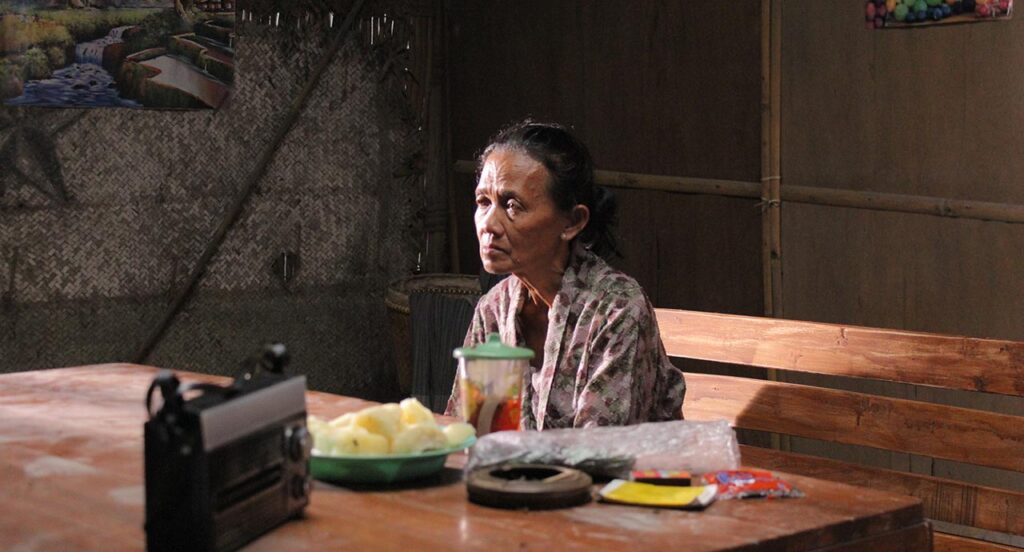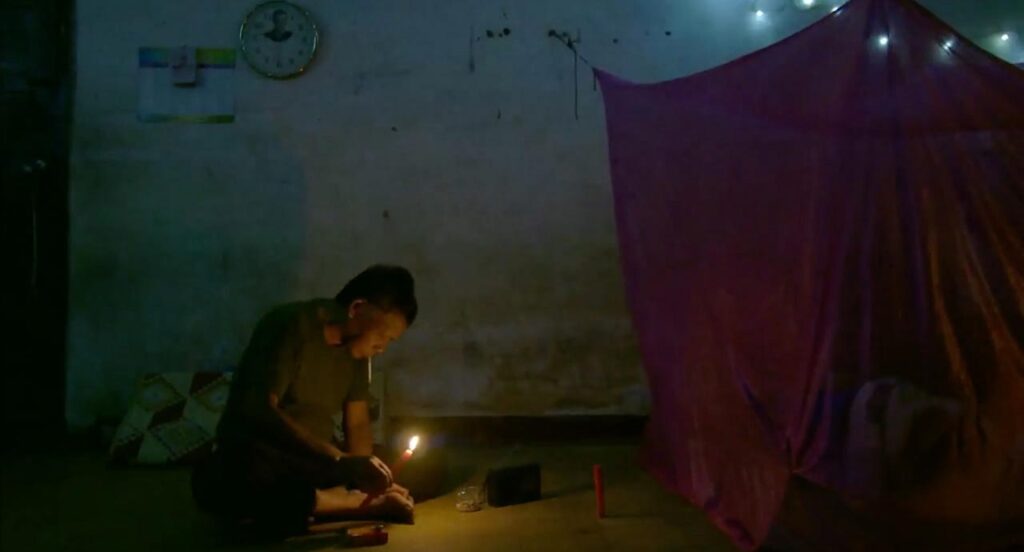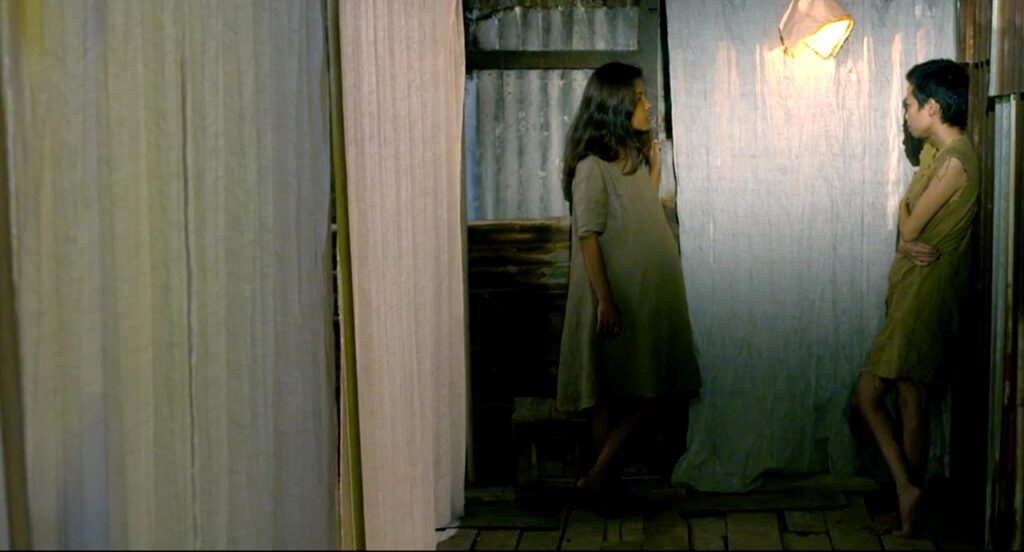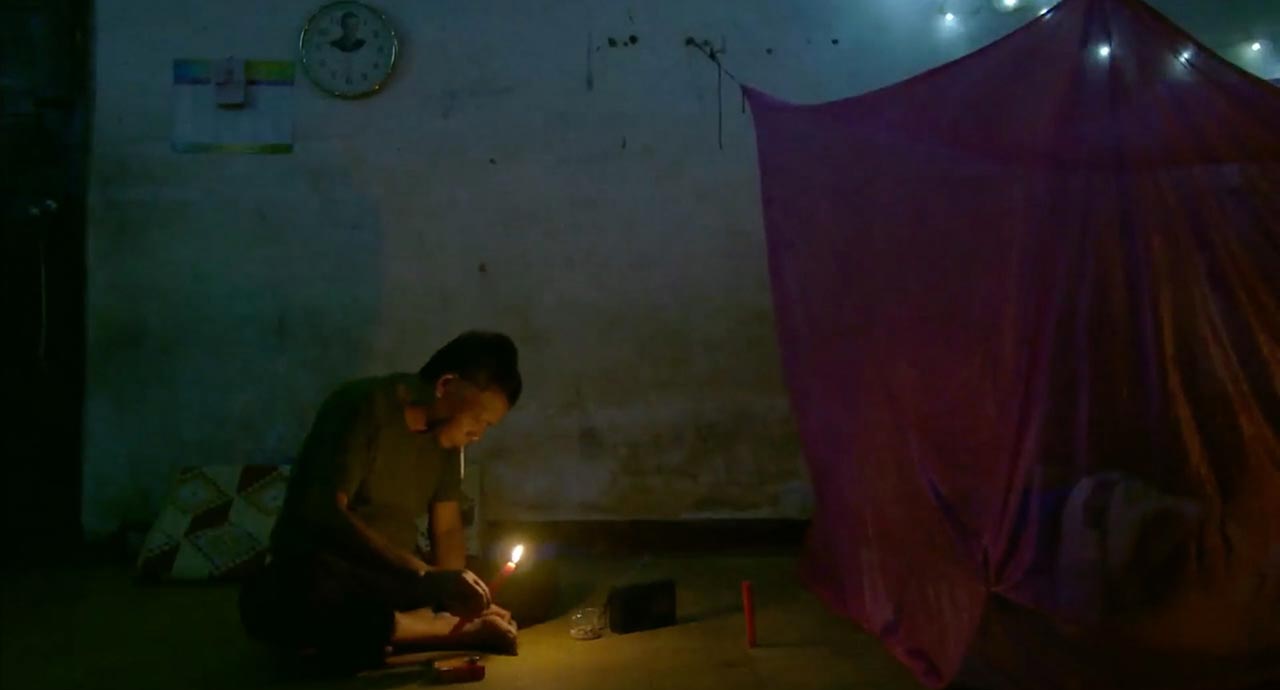Slow Cinema: A Contemporary Asian Cinema Challenge
Part two of our slow cinema feature takes a deeper look at two other short films in the SEA short film competition, Scent and Three Wheels, and discusses the effects that slow cinema has on its audience.
—
Zac: There was a scene toward the end of Three Wheels that lingered with me: the long take with the husband dripping candle wax on the floor and his wife sleeping behind a mosquito net lit by fairy lights. There is a long silence, followed by a simple question that the husband asks his wife, “Shall we move out of here?” The silence amplified his longing for a change in his lifestyle, and made it more meaningful. Kind of like the sudden movement at the end of the static Stray Dogs scene we mentioned in part one.
Say Peng: Similarly for Daughter, the camera was held in a very long mid shot on the mother’s face – a kind of longing – and it makes you pay attention to the details of her face. Following that, her daughter, whom we assumed to be missing, comes home and walks into the frame, and it becomes a more impactful scene because of the abrupt change in direction.
Additionally, regarding the effect of slowness, or the idea of equating real time with cinematic time, our experience of watching the film becomes more concrete, and more based in reality. For instance, in the scene with the dripping of candle wax, happening in real time, our experience of it is inexplicably linked with that of the character’s, and allows us to feel his aimlessness.

Brandon: Agreed. The idea behind presenting real time is so that the audience can go through what the character is experiencing without any cinematic cuts to alter time. In this sense, we can experience the scene in its entirety, all its tensions and complications. It’s surreal – no, almost absurd.

Janel: Perhaps one negative effect of that would be that character reticence may sometimes lead to frustration and impatience for the accustomed mainstream cinema goer, because time there almost never real time, especially with the use of intensified continuity as a form of editing that has become the norm.
That said, I think that a lot of things can be said while unspoken. I think in Scent, two scenes stood out powerfully to me – the first was when the two girls were filmed talking at the end of the corridor, but their voices were deliberately muted from the audience. The sudden absence of sound punctuates the moment, emphasizing the emptiness of their existence.
The second would be when the two of them were sitting in silence in front of a buzzing TV, but you begin to see their friendship emerging through small gestures, such as sharing a cup of water. We also get the sense that they are invisible characters, and their silent actions reveal a shared, inexpressible pain. These emotions are not readily communicated to both themselves and the audience, and we have to make the effort to connect with them.

Brandon: On that note, I think that a common trait of slow cinema is that it does not tell you what to feel, instead it demands more from you. You have to feel your way through the film. They hinge on the emotional investment of the audience, and requires them to be proactive and not simply be a passive observer. It is a different kind of experience in that sense.
Janel: Yes, the intent of slow and deliberate scenes are not to spoon-feed the viewers and explicate emotions. It aims to challenge the way the we view cinema, and access the complexity of human sentiment to an often desensitized viewer. For example, in the first scene I was talking about, I become more attuned to character movements precisely because I cannot know exactly what they are talking about. It prompts me to be more conscious of my ability to empathize and reflect.
Say Peng: Although this is not a key characteristic of slow cinema, another common technique often employed is the use of the wide shot. The wide shot can be seen as the director’s strategy in giving his/her audience the autonomy to explore the frame. Additionally: the wider the shot, the harder it is for the audience to access the emotions of the characters.
Janel: Just as how we cannot access the interiority of the characters, the framing deliberately distances the viewer. At times this also forces you to realize your place as an outsider, while encouraging you to take more effort in understanding these complex characters.
Three Wheels was interesting in that it hardly used any close ups. In that long take we were talking about, we only see the couple in the dark, barely illuminated by light. You can make out a vague façade of the man’s face, and his wife is shrouded by the netting. It is a reminder that we know little of the man, and even less of his wife.
Say Peng: A lot of praise has been showered on slow cinema, but I also think that many young directors have this romanticized idea of slow cinema. And sometimes they use long takes not out of pure reasons, but because of its prestige.
Brandon: Yes, sometimes the technique does not exactly suit the story they are telling, and it becomes more a display of technical virtuosity.
Zac: Here’s when the issue of sincerity comes into the picture again. We are more accepting of a filmmaker’s story and its people when we see that the he/she isn’t just showing off or stringing us along. And of course, we should also learn to acknowledge that sincerity can be a very subjective thing – which is why both Birdman and Tree of Life can have so many detractors even though they are brilliantly executed films.
Say Peng: Both the audience and the filmmaker have their own responsibilities. The filmmaker should not abuse the long take, and at the same time, the audience should not outright dismiss a film in which the pace is slow and nothing seems to be happening.
Janel: Susan Sontag once said that “ in a given written text or piece of music or film, if we become bored, we should ask if we are operating in the right frame of attention.” And I think that is a fitting thought to end off our discussion on slow cinema.


